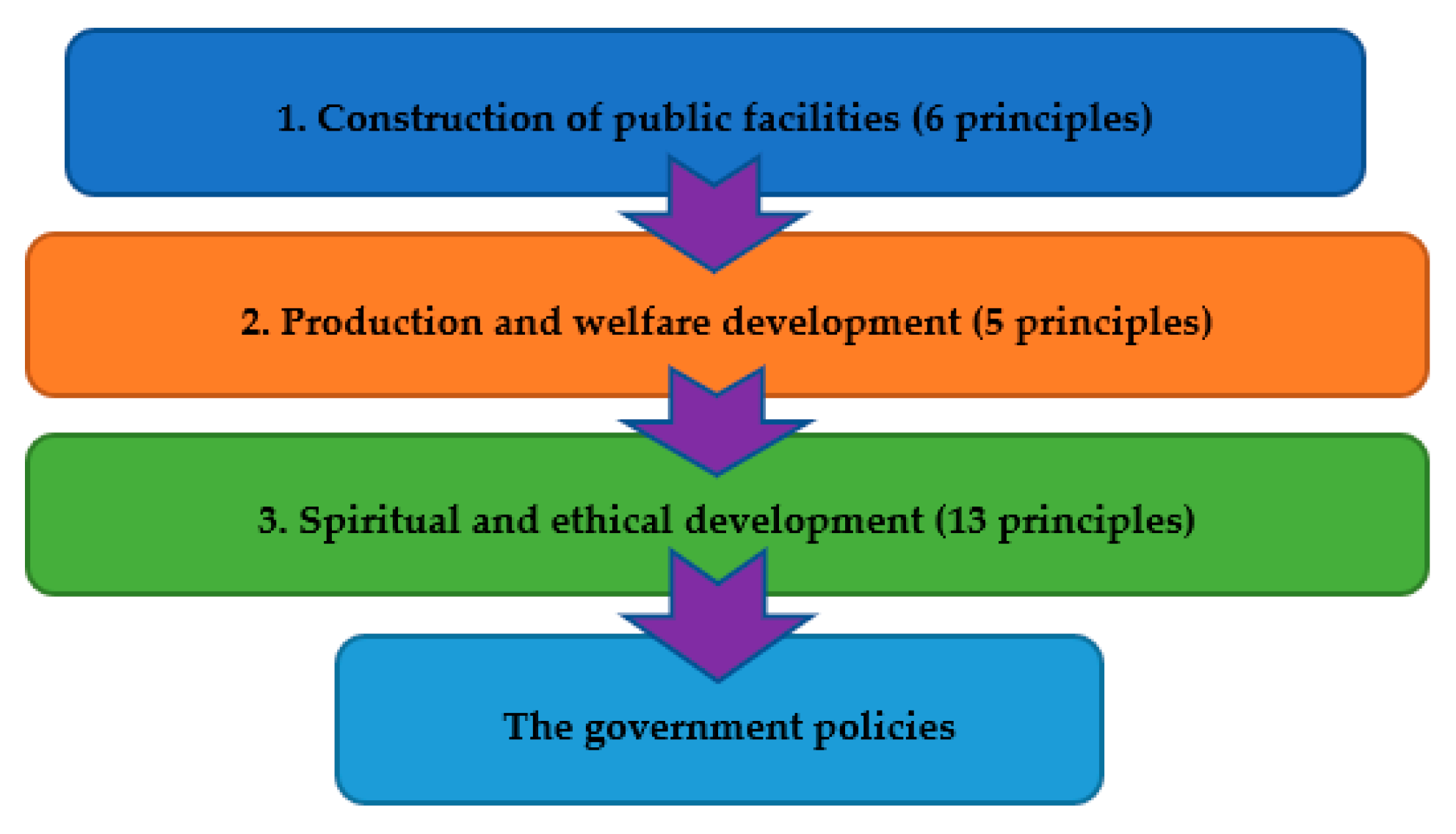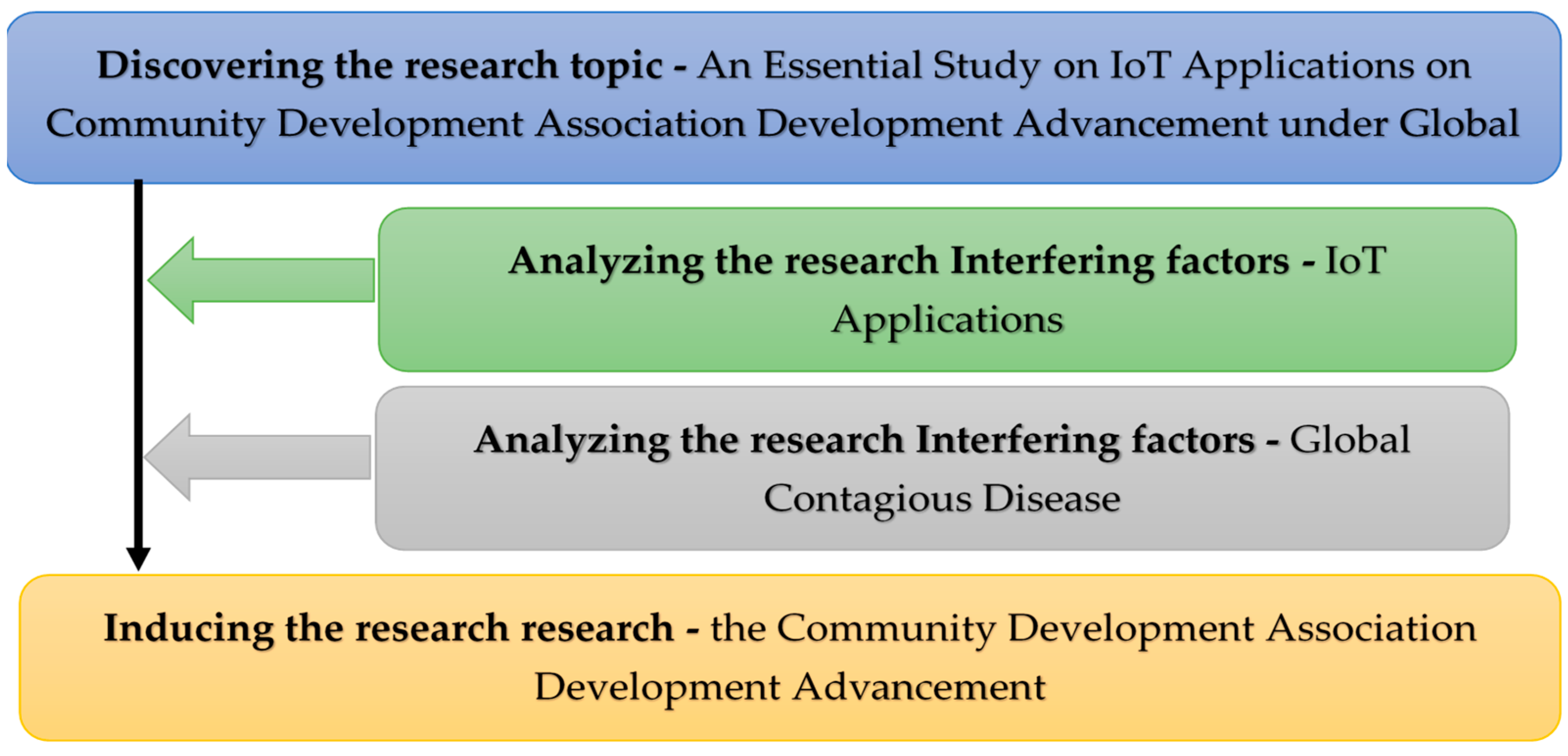An Essential Study on IoT Applications on Community Development Association Development Advancement †
Abstract
1. Introduction
- The construction of public facilities:
- (1)
- The construction or repair of community centers.
- (2)
- Protecting the environment and improving sanitation in communities.
- (3)
- The maintenance of roads and gutters in communities.
- (4)
- The collation of and increase in parking facilities.
- (5)
- Community greening and beautification.
- (6)
- Other matters relating to the construction of public facilities.
- The development of production and welfare:
- (1)
- The establishment of community production and construction funds.
- (2)
- The promotion of social welfare.
- (3)
- The establishment of community nurseries.
- (4)
- Promoting the development of community businesses.
- (5)
- Other matters relating to the development of production and welfare.
- Spiritual and ethical development:
- (1)
- Important measures for improving the ethos of society as well as advocating and promoting models of public etiquette.
- (2)
- The maintenance and promotion of rural culture and traditional crafts.
- (3)
- The establishment of traffic safety in the community.
- (4)
- The establishment of community pacts.
- (5)
- The promotion of civil defense.
- (6)
- The establishment of art and recreation teams.
- (7)
- The establishment of community senior citizens’ clubs.
- (8)
- The establishment of community growth classrooms.
- (9)
- The establishment of community volunteer service teams.
- (10)
- The establishment of community libraries.
- (11)
- Advocating for community-wide activities.
- (12)
- Promoting community disaster reporting and prevention drills.
- (13)
- Other matters relating to spiritual and ethical development.
2. Conceptual Literature
3. Conclusions and Future Direction
Author Contributions
Funding
Institutional Review Board Statement
Informed Consent Statement
Data Availability Statement
Conflicts of Interest
References
- The Article 12 of the Regulations on Community Development Work; Ministry of Health and Welfare: Taipei, Taiwan, 2014.
- Hsieh, M.-Y. Interdisciplinarily Exploring the Most Potential IoT Technology Determinants in the Omnichannel E-Commerce Purchasing Decision-Making Processes. Appl. Sci. 2020, 10, 603. [Google Scholar] [CrossRef]
- Hsieh, M.Y. The Most sustainable niche principles of social media education in a higher education contracting era. Sustainability 2020, 12, 399. [Google Scholar] [CrossRef]
- Huang, Y.-M.; Hsieh, M.Y.; Usak, M. A Multi-Criteria Study of Decision-Making Proficiency in Student’s Employability for Multidisciplinary Curriculums. Mathematics 2020, 8, 897. [Google Scholar] [CrossRef]
- Chan, Y.-K.; Hsieh, M.Y.; Usak, M. A Concrete Study on Social-Media Connection of Global Literacy Abilities in MOOCs under the Dual Impacts of Lower Birth-Rate and COVID-19. Sustainability 2021, 13, 2203. [Google Scholar] [CrossRef]
- Usak, M.; Hsieh, M.Y.; Chan, Y.-K. A Concretizing Research on Making Higher-Education Sustainability Count. Sustainability 2021, 13, 2724. [Google Scholar] [CrossRef]
- Duran, M.; Usak, M.; Hsieh, M.-Y.; Uygun, H. A New Perspective on Pedagogical Content Knowledge: Intellectual and Emotional Characteristics of Science Teachers. Rev. de Cercet. si Interv. Sociala 2021, 72, 9. [Google Scholar] [CrossRef]
- Wu, T.-L.; Hsieh, M.-Y.; Min, K.-W.; Yu, M.-T.; Ho, C.-T. Use of Sensor Technologies in Online Courses in Post-COVID-19 Era. Sensors Mater. 2021, 33, 2045–2062. [Google Scholar] [CrossRef]
- Huang, C.-C.; Chan, Y.-K.; Hsieh, M.Y. The Determinants of ESG for Community LOHASism Sustainable Development Strategy. Sustainability 2022, 14, 11429. [Google Scholar] [CrossRef]
- Chan, Y.-K.; Hsieh, M.-Y. An Empirical Study on Higher Education C-ESG Sustainable Development Strategy in Lower-Birth-Rate Era. Sustainability 2022, 14, 12629. [Google Scholar] [CrossRef]
- Hsieh, M.-Y. Online learning era: Exploring the most decisive determinants of MOOCs in Taiwanese higher education. Eurasia J. Math. Sci. Technol. Educ. 2016, 12, 1163. [Google Scholar] [CrossRef]
- Hsieh, Y.-M. Employing MCDM methodology to verify correlationship between social media and service quality in the dynamic m-commerce era. J. Internet Technol. 2018, 19, 225. [Google Scholar] [CrossRef]
- Hsieh, Y.-M.; Usak, M. High Education Radical Transformation Era: How Teachers’ Competency can Enhance the Students’ Employability. Rev. Cercet. Interv. Soc. (RCIS) 2020, 68, 95. [Google Scholar]
- Huang, Y.-M.; Hsieh, M.-Y. An Interdisciplinary Research on Students’ Employability in Technology Education to Advance Higher Education Enrollment Sustainability. Sustainability 2020, 12, 1806. [Google Scholar] [CrossRef]
- Hsieh, M.-Y. The Sustainable Development and Strategic Approaches for Contemporary Higher Education. Sustainability 2022, 14, 12925. [Google Scholar] [CrossRef]
- Huang, C.-C.; Chan, Y.-K.; Hsieh, M.Y. Preliminary Research on the Sustainable Determinants of Taiwanese Ecotourism with the International Standards. Int. J. Environ. Res. Public Health 2022, 19, 14489. [Google Scholar] [CrossRef] [PubMed]


Disclaimer/Publisher’s Note: The statements, opinions and data contained in all publications are solely those of the individual author(s) and contributor(s) and not of MDPI and/or the editor(s). MDPI and/or the editor(s) disclaim responsibility for any injury to people or property resulting from any ideas, methods, instructions or products referred to in the content. |
© 2023 by the authors. Licensee MDPI, Basel, Switzerland. This article is an open access article distributed under the terms and conditions of the Creative Commons Attribution (CC BY) license (https://creativecommons.org/licenses/by/4.0/).
Share and Cite
Lai, J.-C.M.; Wang, C.-L.; Hsieh, M.-Y. An Essential Study on IoT Applications on Community Development Association Development Advancement. Eng. Proc. 2023, 38, 35. https://doi.org/10.3390/engproc2023038035
Lai J-CM, Wang C-L, Hsieh M-Y. An Essential Study on IoT Applications on Community Development Association Development Advancement. Engineering Proceedings. 2023; 38(1):35. https://doi.org/10.3390/engproc2023038035
Chicago/Turabian StyleLai, Jiin-Chyuan Mark, Chiung-Ling Wang, and Ming-Yuan Hsieh. 2023. "An Essential Study on IoT Applications on Community Development Association Development Advancement" Engineering Proceedings 38, no. 1: 35. https://doi.org/10.3390/engproc2023038035
APA StyleLai, J.-C. M., Wang, C.-L., & Hsieh, M.-Y. (2023). An Essential Study on IoT Applications on Community Development Association Development Advancement. Engineering Proceedings, 38(1), 35. https://doi.org/10.3390/engproc2023038035








